North Carolina
Number of Victims
Over 8,000 sterilizations were approved by the Eugenics Board of North Carolina. The total number of
victims actually sterilized is estimated to have been over 7,600 (Winston-Salem, “Lifting the
Curtain on a Shameful Era”). Of this number, females represented approx.
85% of those sterilized (State Library,
“Statistics,” p. 1). By the late 1960s, the sterilization of men was
virtually halted, as women made up 99% of those sterilized (Sinderbrand, p. 1). African Americans represent 39% of those sterilized overall; by the later
1960s, they made up 60% of those sterilized, even though they made up only a
quarter of the population (Sinderbrand, p. 1). Of those sterilized
up to 1963, 25% were considered mentally ill and 70% were considered mentally
deficient. In each of these categories, females account for over 75% of
the sterilizations. Of all the states, North Carolina ranked third
in the United States for number of people sterilized.
Period during Which
Sterilization Occurred
Sterilizations started
in 1929 with the passage of the sterilization law and continued through 1973,
when the last recorded sterilization is known to have occurred.
Temporal Pattern of Sterilization

After the passage of the
sterilization law in 1929, sterilization law began at fairly slow rate.
It was not until about 1938 that sterilizations began to increase at a steady
rate. After WWII, sterilizations accelerated and peaked in the two years
between 1950 and 1952, with 704 sterilizations (State Library, “Statistics”, p.
1). This makes North Carolina fairly unique, as its peak sterilizations occurred
after WWII when most other states had ceased performing operations (see also Iowa and Georgia). After
1960, the rate of sterilization began to slow and continued to decrease from a
rate of about 250 a year in 1963 to 6 per year in 1973. From 1950-1963
there were an average of about 300 sterilizations per year. In the
peak years (the 1950s) there were about 7 sterilizations for every 100,000
residents of the state per year.
Passage of Laws
The
very first
sterilization law was passed in 1919 but it was probably never
used. Many feared that the law was unconstitutional and therefore
the
state feared putting it into practice (Paul, p. 420). In 1929,
The North Carolina General Assembly passed its sterilization law
stating,
“the governing body or responsible head of any penal or charitable
institution
supported wholly or in part by the State of North Carolina, or any
sub-division
thereof, is hereby authorized and directed to have the necessary
operation for
asexualization or sterilization performed upon any mentally defective
or
feeble-minded inmate of patient thereof” (State Library, “History”, p.
1). It also stated that the operation had to be in the best
interest of
the mental, moral, or physical improvement of the individual, or for
the public
good. In 1933, North Carolina enacted the sterilization law that
remained
for the rest of the eugenics movement there. This law “provided
for
notice, hearing, and the right to appeal” (Paul, p. 421). The
passage of
this law also created the North Carolina Eugenics Board, addressed
below. The passage of the 1929 sterilization law made North
Carolina the 17th state out of 33 to pass one. This law
remained effective until 1973, when the last recorded sterilizations were
performed (State Library, “History,” p. 1). Finally, on April 4, 2003,
the North Carolina Senate voted unanimously to overturn the 74-year-old
eugenics law (“Bill to Overturn Eugenics Law Passes State Senate,” p. 1).
Groups Identified by the
Law
As stated in the
original sterilization law of 1929, the groups targeted for sterilization were
identified as “mentally ill, mentally retarded, and epileptic” (Paul, p.
421). However, the law also stated that the purpose of sterilization is
to protect impaired people from parenthood who would become seriously
handicapped if they were to assume parental responsibilities (Paul, p. 421).
Although the original
sterilization law was deemed unconstitutional by the Supreme Court, the state
of North Carolina instituted a Eugenics Board made up of high ranking public
health officials. Their main purpose was to decide whether sterilization
petitions should be carried out. These Board members were addresses cases
of indiduals diagnosed as feeble minded or mentally ill (Gardella, p. 108). Another
major goal of sterilization was to keep the “handicapped” from perpetuating
themselves. Sterilization was seen as a way to prevent the spending of tax
dollars on the “feeble-minded” (Gardella, p. 108).
Process of the Law
Under the sterilization
law, the North Carolina General Assembly gave the governing body or executive
head of any penal or charitable public institution the authority to order
the sterilization of any patient or inmate whose operation they considered would be
in the best interest of the individual and of the public good. It also
gave the county boards of commissioners authority to order sterilization at the
public’s expense of any “mentally defective or feeble-minded resident upon
receiving a petition from the individual’s next of kin or legal guardian”
(State Library, “History”, p. 1). All the orders for sterilization
had to be reviewed and approved by the commissioner of the Board of Charities
and Public Welfare, the secretary of the State Board of Health, and the chief
medical officers of any two state institutions for the feeble-minded or
insane. In the reviewing process, they looked at a medical and family
history of the individual being ordered for sterilizations to help decide
whether the operation would be performed or not. They also considered
whether it was “likely that the individual might produce children with mental
or physical problems” (State Library, “History”, p. 1).
In 1933, under the new
law, the General Assembly created the Eugenics Board of North Carolina to
review all orders for sterilization of “mentally diseased, feeble-minded, or
epileptic patients, inmates, or non-institutionalized individuals” (State Library,
“History”, p. 1). This centralized board included five members: the
commissioner of the Board of Charities and Public Welfare, the secretary of the
State Board of Health, the chief medical officer of a state institution for the
feeble-minded or insane, the chief medical officer of the State Hospital at
Raleigh, and the attorney general. In the hearings of patients or
inmates in a public institution, the head of that institution was the
prosecutor in presenting the case to the Eugenics Board. In hearings of
individuals who were non-institutionalized, the county superintendent of
welfare or another authorized county official acted as the prosecutor.
However, in both hearings, the prosecutor provided the board with a medical
history signed by a physician familiar with the individual’s case. The petition
for the hearing was sent to the individual being ordered or to their next of
kin or legal guardian. In the situation where this person could not
represent or defend themselves at the hearing, the next of kin, guardian, or
county solicitor stepped in to represent them. If the board decided to
order the sterilization, the order had to be signed by at least 3 members and
then returned to the prosecutor. This decision could be appealed by the
individual to the county superior court and then further appealed to the state
supreme court. If the appeal was successful, any petitions for
sterilization were prohibited for one year, unless the individual, or his or
her guardian or next of know requested sterilization (State Library, “History”,
p. 1).
Precipitating
Factors and Processes
Eugenics
in the 1950s
was to some extent a southern phenomenon, as many states in other
regions saw their number of sterilizations drop. Few
sterilizations occurred in the 1930s in North Carolina
(and in the other southern states) because the Great Depression
resulted in
funding crises that didn’t allow for sterilization to occur in full
force in
the South. Sterilization picked up pace after WWII, especially
during the mid-1950s (Castles, p. 1).
One
factor leading to
the acceleration after WWII was the race issue. Race has
always
been a loaded issue in the south, as slavery was prominent there.
When slavery was legal, white slave owners encouraged the reproduction
of their
slaves in order to create bodies to work and sell. The legacy of
considering poor Blacks as a source of cheap servant labor
continued. By the 1950s, some in the white majority were becoming
anxious
about supporting blacks through welfare. The heads of the
agencies of
welfare departments agreed on the value of sterilization for reducing
general
welfare relief and ADC (Aid for Dependent Children) payments
(Winston-Salem,
“Wicked Silence”). Some erroneously believed that blacks
accounted for the
majority of illegitimate births that were “subsidized” by ADC.
The state
threatened to remove welfare benefits if the person did not submit to
the
operation. The fears about the rising cost of the ADC program was a major factor in leading to the shift in racial composition of those
targeted for sterilization. As the attention shifted away from the
structural causes of poverty and crime to placing the blame for urban poverty
and social unrest on blacks, sterilization of blacks was facilitated (Schoen, Choice and Coercion; see also Schoen, "Reassessing," p. 149). It was believed the control the reproduction of ADC
recipients was necessary; as a result, the percentage of Blacks sterilized rose from 23% in
the 1930s and 1940s to 59% between 1958-60 and finally to 64% between 1964 and
1966 (Schoen, Choice and Coercion, p. 108; "Reassessing," p. 149).
Sterilization also accelerated because it expanded to include the general population when the state gave social workers the authority to submit petitions for sterilization. Therefore, the amount of eligible people increased drastically. “The North Carolina Board-which initially targeted those who were deemed mentally ill, expanded its program to include the general population. In fact, “the majority of those sterilized had never been institutionalized, and 2,000 were younger than 19” (Wiggins, p. 1). In addition, the fight against poverty in North Carolina led to sterilizations in the general population. As this fight intensified, a new policy was created that led to an increase in the number of non-institutionalized people who were sterilized. Sterilizations of the non-institutionalized rose from 23% between 1937 and 1951 to 76% between 1952 and 1966 (Schoen, Choice and Coercion, p. 109, "Reassessing," p. 151).
The Human
Betterment League made it their mission to spread information to the public
regarding the “benefits of eugenic sterilization” (Gardella, p. 110). At the
University of North Carolina State Public officials from the department of
sociology searched for any possible people eligible for eugenic sterilization.
Eventually through their efforts and the upholding of the state’s sterilization
law North Carolina eve managed to sterilize the non-institutionalized
(Gardella, p. 110)
Other
Restrictions Placed on Those Identified in the Law or
with Disabilities in General
There are
no other
known restrictions placed on those identified in the law.
Groups
Targeted and Victimized
Women
77percent of all those
sterilized in North Carolina were women. North Carolina carried out 50 percent
of these between 1929 and 1947 on females under the age of twenty (Cahn,
p.162). There was a strong historical mentality in the south that supported the
idea of trying to control the reproduction of women, and African Americans
which helped the idea of eugenics to spread from the North to the South with
little opposition from the elitist White male population. Because of the strong
belief in moral purity of the South, however it was easy to explain why White
women were just as endangered as African American women.
Physicians in North
Carolina didn’t leave any margin for error either. Many women were brought in
under the pretext that they might have been exhibiting behaviors that were
sexual in nature and thus increasing the possibility of sexual promiscuity and
warranting eugenic sterilization (Cahn, p. 165).
Women that were deemed
“subnormal” intellectually were also likely to be forcibly sterilized. About
sixty percent of the inmates at a North Carolina Farm Colony in the 1930’s were
considered feebleminded and candidates for sterilization (Cahn, p.165). The
greatest fear with women was that they are deceiving to others as they are
still attractive to men and yet are below the standards for reproduction. North
Carolinian journalists reported on these issues stated that these morons would
breed rapidly “like mink” and “contaminate” the whole “healthy human stock,”
(Cahn, p.166). And most of the women that they felt needed to be sterilized
most were those women that exhibited no outward sign of incompetence but simply
didn’t do well on IQ tests because these women’s “charm of personality and
conversation l ability…posed a greater social threat than more obviously
disabled persons since their very attractiveness would lead to more
opportunities for illicit sex or marriage and , thus a, the likelihood of
starting a “family of future liabilities to the State” (Cahn, p. 168).
Women were not safe even
if they somehow managed to flee the State of North Carolina either. Such
sexually deviant women could be chased all the way to Florida, as was the case
for Emma Suggs. She was a candidate for sterilization because of her mental
state due to her past and her “out of wedlock pregnancy” (Cahn, p. 169).
Soon North Carolina set
its sights on women of color who were seen as likely to be on welfare and to
have illegitimate children. Chapel Hill Weekly stated that there was a
“higher proportion of Negroes than whites: and noted that “the
feebleminded Negro woman, often with illegitimate children, is a familiar and
recurrent problem to health and welfare agencies” (Cahn, p. 177).
Women, including wives,
daughters, sisters and unwed mothers, were overrepresented. They
were labeled as either “promiscuous, lazy, or unfit” (Wiggins, p. 1), or more
commonly as “sexually uncontrollable” (Schoen, Choice and Coercion, p. 110). Overall, women made up 84.8% of
sterilizations (State Library, “Statistics”, p. 1). However, more
interesting is that the sterilization of men virtually halted in the 1960s,
with only 2 sterilizations in 1964, and 254 sterilizations of women (State
Library, “Sterilizations”, p. 1). Therefore, after 1960, women accounted
for 99% of sterilizations (Sinderbrand, p. 1). While many white
women were sterilized, the state began to focus on sterilizing black women as
they became the majority of the welfare population. Black women were seen
as highly uneducated, poor, and as having higher fertility rates than their
white female counterparts. Schoen noted that as the amount of black women
on welfare increased “the public association between ADC and black female
recipients was particularly close” (Schoen, Choice and Coercion, p. 109; see also "Reassessing," p. 153).
Black women were presumed to have uncontrollable sexual behavior, and as these
racial stereotypes were reinforced, black women became an even larger target
for controlled reproduction through sterilization.
Social class also played
a role in who was targeted after WWII, as women on welfare, usually living in
socially isolated places, were overrepresented. The reason for this was
to prevent “poor” and “unfit” women from reproducing children with mental or
social ills (Wiggins, p. 1). They were generally ordered for
sterilization by social workers and lived outside of institutions. The
poor were not only targeted for their “social ills” but also because they were
easier to sterilize. They would often not be released until they or a
family member agreed to have them sterilized (Wiggins, p. 1).
Women that were social
workers were strong supporters for the eugenics movement. Johanna Schoen (2011) has
argued that some social workers provided sterilization out of
empathy. However, Krome-Lukens maintains that women were often coerced and that
many social workers provided sterilizations as an opportunity to save money
from future drains on society (Krome-Lukens, p. 49). Interestingly
enough—according to Krome-Lukens—eugenics was a key element of progressive
reform and was indicative of the new mentality surrounding sexuality and the
standard gender roles of the time (Krome-Lukens, p. 9).
Finally, race also
played a role in those targeted for sterilization. During the Civil
Rights Movement, petitions were sent to the state’s eugenics board for black
women (Winston-Salem, “Wicked Silence”). Overall, by the later 1960s, 60%
of those sterilized were young, black women (Wiggins, p. 1). Overall,
blacks represent 38.9% of sterilizations. This is because sterilizations
of blacks were concentrated in a shorter period of time and because minorities
only made up quarter of North Carolina’s population (State Library,
“Statistics”, p. 1). From the years 1960 to 1962, of the 467
sterilization ordered by the board, 284 (61%) were black (Winston-Salem,
“Wicked Silence”). In addition, blacks were targeted because the amount
of welfare recipients who were black grew from 31% in 1950 to 48% in 1961 (Schoen, Choice and Coercion, p. 109; see "Reassessing," p. 151). It was seen as necessary to sterilize those
recipients of welfare to decrease the growing financial burden on the
state.
There are two stories
that were made public by two black women who were sterilized against their will
at a young age in North Carolina. The first is Elaine Riddick, who had
been sterilized at the age of 14 by a state order in North Carolina in 1968
after giving birth to a baby after being raped. When she was operated on she
was not informed that she was being sterilized. She only discovered this
years later when she was trying to get pregnant with her husband. She was
part of the lower class and the consent form had been signed by her illiterate
grandmother and neglectful father. She blames the sterilization for
ending her marriage and is still affected by the surgery, saying, “I felt like
I was nothing. It’s like, the people that did this; they took my spirit
away from me” (Sinderbrand, p. 1).
The second story is of
Nial Cox Ramirez, who was sterilized at the age of 17 after several instances
of pressure from social workers to get sterilized after becoming
pregnant. She eventually complied because they threatened to take her
family off of welfare, but she was never informed of the consequences of the
surgery. She was assured she would be able to become pregnant again, but
learned otherwise when she attempted to conceive years later. Like
Riddick, her marriage fell apart. When she sued the state of North Carolina
in 1967, it was dismissed as a technicality (Wiggins, p. 1). These women
were only 2 of those who fell under the categories of the groups targeted, and
suffered as a result.
It was believed that
Black Americans were of lower caliber and practiced reckless breeding (Larson,
p.156). However, North Carolina took an ever more grand approach to solving
their genetic woes. North Carolina, instituted a birth control program geared
towards giving poor women a more acceptable and less costly way to prevent
unwanted pregnancies claiming that it would “be taught when the economic status
precludes adequate care” (Larson, p.157).
Young children were also targeted by these eugenic practices. A teenage girl from North Carolina was the object of her father’s affections. She was given a physical and the doctors realized that she’d had sexual intercourse. As a result he parents gave consent to have their daughter sterilized instead of reprimanding the father for sexually assaulting his daughter (Ariyo, p. 59).
Sterilization of Julius Wilson: Mistreatment of the Mentally and Physically Disabled
 (Source: http://www.racialicious.com/2009/05/26/when-systems-of-oppression-intersect-mental-health-and-the-immigration-system/)
(Source: http://www.racialicious.com/2009/05/26/when-systems-of-oppression-intersect-mental-health-and-the-immigration-system/)
Junius Wilson (Source:Junius Wilson was born
in 1908 to Sidney and Mary Wilson (Burch, p. 1). He was born deaf in and so his
literacy level was extremely low. At the age of eight he was sent away to a
residential North Carolina School for the deaf and blind in Raleigh. This was
America’s first school created to care for the special needs black children
(Burch, p. 20). He was never taught proper sign language and so his family members
often would misunderstand him or misinterpret gestures that he made, and he
also did not understand the things that his family members were telling him, as
his mother could not teach him how to read and write (Burch, p. 18). Because of
the confusing communication, some of his family members suspected that he had
assaulted one of his own family members sexually. In this community he was
somewhat safer from his family however he was sent here not for deafness per se
but for his perceived mental deficiencies and sexual deviations. Here in this
institution Wilson became a member of ka community that was equally
misunderstood and equally ostracized by the greater community. They were all
people of color and they were all unable to communicate by normal conventions.
They were never officially taught ASL (American Sign Language) as they were all
people of color and at the time no one saw fit to use their teaching resources
on Blacks. They instead developed their own gestures and signs to communicate
with one another and to the staff members in the institution. This form of sign
language was entirely unique to these people. As a result, the deaf Blacks from
Raleigh could not communicate with other signing deaf people, and far less
could they be understood by their hearing peers (Burch, p. 22).
Southern states had a
strong history of segregation. It is not unexpected that there would be
significant repercussions to the Jim Crow policies of the south. And this
mentality of separation and White superiority bled the special education
programs of even the most progressive places south of the Mason Dixon, like
North Carolina. Gustavus Ernest Lineberry became the superintendant for the
North Carolina School for the Colored Blind and Deaf in 1918, after this the
quality of education changed dramatically. Lineberry was a firm believer in the
teaching of the blind and deaf, even the Blacks, but he was not so kind as to
consider the needs of his White and Black students to be the same (Burch, p.
22). He completely redistributed the resources of the school so that the best
teachers and alumni were teaching at the White schools. He then made sure to
provide a far less academic curriculum for the Blacks, as he felt there was a
dire need to keep Blacks “in their place” (Burch, p. 22). The Black students
with physical disabilities were given an education that would prepare them for
rudimentary, vocational labor so that they could prove their worth to society
‘boys were taught shoe repairing, carpentry and cabinetmaking along with dairy work,”
(Burch, p. 22). It was also clear that this vocational form of training,
towards fields that required little interaction, lowered the cost that their
programs would incur and made the need for sufficient literacy nearly
unimportant.
This, however, created a
great deal of socialized problems for the students participating in the
programs. Everyone sent to the school for the Colored Deaf and Blind was sent
there to become better functioning and well prepared to rejoin society. But the
students were not exposed to role models that were not fluent in sign and who
did not know how to supply the needs of the deaf and blind. And because of the
segregation that was taking place students could not even be taught by their
White peers secretly, because they were transferred to Morganton (Burch, p.23).
Goldsboro Asylum
during the Great Depression
Junius Wilson was
becoming too much of a burden for his family as he became older, and his
communication with them had not really improved either which was greatly to his
detriment. His family decided that the best thing they could do in their
situation was to have Wilson committed to a mental asylum. He was given up to
the police by his family under the charge of attempted rape. However, it is
clear that not everyone was on board with this idea. Although, his mother
allowed them to take him away it was said that she didn’t approve of the
decision and would not speak with André, his father, because he was the one
that supported removing his son permanently.(Burch, p. 129)
Wilson was moved to
Goldsboro Asylum in a farming colony. North Carolina was experiencing the
debilitation of the Great Depression just like everyone else at the time and so
holding whole mental institutions was more of a juggling act than those that
ran the institutions could bear alone. Goldsboro opened up farming colonies in
order to defer some of the costs involved in feeding inmates by having the
inmates work for the food that they ate. The institution even went so far as to
send inmates to other farms so that they could make money for the asylum. One
could look at this as a sad combination of economic desperation seasoned with
the racism of the south and the disregard for the mentally and physically
disabled. (Burch, p. 76)
Freedom for Wilson
After a great deal of
mistreatment however, Junius Wilson’s case was taken up by John Wasson, who
noted that Wilson was being held in the Asylum for “phase of life adjustment
disorder” something he felt didn’t warrant a seventy year stay in a mental
institution (Burch, p. 128). In a major State court case Junius Wilson v.
the State of North Carolina Wilson was finally granted his freedom and a
cottage to call his own on the outskirts of the Hospital property at Goldsboro.
The Years after Junius
Wilson
Wilson’s
story continued
to have a significant impact after his death. His case which he brought
through
the North Carolina judiciary as a result of his poor treatment and
wrongful
sterilization was a model that others used in order to seek
compensation for
the trauma caused (Burch, p. 214). The state of North Carolina has made
great
efforts to own up to its involvement in the eugenics movement. In 2003
North
Carolina was one of the first states to repeal the eugenic
sterilization laws.
Unfortunately it has taken until very recently for any party afflicted
by the eugenics laws to be officially recognized and
monetarily compensated. Until the 2009-2010 session of the State
Legislature of North Carlina, it had been one promise after another
with only
symbolic acknowledgement being offered (Burch, p. 215). (See also below
on
compensation for victims.)
Major
Proponents
Dr.
William Allan was North Carolina’s
initial promoter of negative eugenics.
He wrote his first study on eugenics in 1916 and by the
end of his life
he had written 93 papers. He
had his own
private practice until 1941, when he started the medical genetics
department at
Bowman Gray. He
thought that hereditary
diseases could be halted by prevention and based much of his work on
field
studies and surveys. He
pushed for a
statewide bank of genetic information that would catalog peoples’
genetic
backgrounds to see if they were prospective parents.
He continued to push for this until his death
in 1943 (Winston-Salem, “Forsyth in the Forefront”).
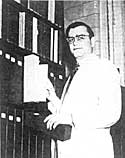 . (Photo
origin: Winston Salem Journal, Against Their Will,
available at
http://media.gatewaync.com/wsj/photos/specialreports/againsttheirwill/graphics/parttwo_herndonsmall.jpg)
. (Photo
origin: Winston Salem Journal, Against Their Will,
available at
http://media.gatewaync.com/wsj/photos/specialreports/againsttheirwill/graphics/parttwo_herndonsmall.jpg)
Dr. C.
Nash Herndon followed in the
footsteps of Allan when he took over the department at Bowman Gray
after his
death. He conducted
surveys of those
with disabilities in an effort to find links of hereditary diseases. He was president of the
American Eugenics
Society from 1953-1955 and president of the Human Betterment League of
North
Carolina. He was
the greatest
contributor in pushing the eugenics movement forward in North Carolina
after
WWII (Winston-Salem, “Forsyth in the Forefront”).
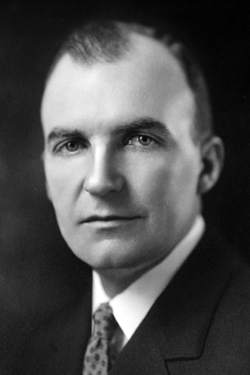 (Source: http://www.ci.winston-salem.nc.us/Home/DiscoverWinston-Salem/History/Articles/Winston-SalemMayorsBiographies)
(Source: http://www.ci.winston-salem.nc.us/Home/DiscoverWinston-Salem/History/Articles/Winston-SalemMayorsBiographies)
Ira M. hardy was the Superintendent at the North Carolina School for the Feeble-Minded. She appealed to the Southern Medical Association that took place in Florida expressing her deep desire to make the mentally ill completely separate from the rest of the population (Larson, p. 46).
Kate Burr Johnson was female
social worker during the era of eugenic sterilization. She was a major
proponent of the movement of compulsory sterilization. Johnson claimed that she
wanted women to be liberated and be provided with reproductive freedom;
however, she was actually strongly supporting the eugenic sterilization of
people that would become social liabilities and produce unfit or economically
unstable offspring (Krome-Lukens, p. 3).
“Feeder
Institutions” and institutions where sterilizations were
performed
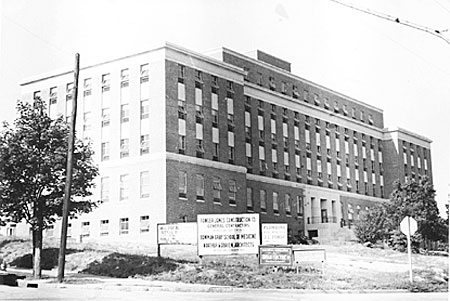 (Photo
origin: Winston Salem Journal, Against Their Will,
available at
http://media.gatewaync.com/wsj/photos/specialreports/againsttheirwill/graphics/parttwo_bowman.jpg)
(Photo
origin: Winston Salem Journal, Against Their Will,
available at
http://media.gatewaync.com/wsj/photos/specialreports/againsttheirwill/graphics/parttwo_bowman.jpg)
The Bowman Gray School of Medicine housed a program for eugenic sterilizations starting in 1948. It was aimed at the eugenic improvement of the population of Forsyth County. It consisted of a systematic approach that would eliminate certain “genetically unfit strains from the local population” (Winston-Salem, “Forsyth in the Forefront”). It expanded the program throughout North Carolina. The school received much philanthropic support for research of genetic ideas. Today, school officials condemn eugenic research, as the dean of the school, Dr. William B. Applegate, states “I think that the concepts and the practice of eugenics is wrong and unethical and would in no way be approved or condoned in modern medical times” (Winston-Salem, “Forsyth in the Forefront”). The school is now part of the Wake Forest University Baptist Medical Center-one of the most respected academic medical centers in the country. Although officials of the school condemn eugenics there is no mention of the program for eugenic sterilizations on the medical center’s website.
 (Photo origin: North Carolina Department of Health and Human
Services, available at
http://www.dhhs.state.nc.us/mhfacilities/images/Caswell-Center.jpg)
(Photo origin: North Carolina Department of Health and Human
Services, available at
http://www.dhhs.state.nc.us/mhfacilities/images/Caswell-Center.jpg)
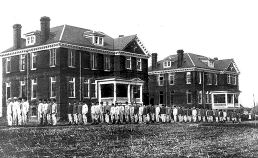 (Source: http://www.ncgenweb.us/cabarrus/Photos/HistMarkers/StonewallJacksonTrainingSchool.jpg)
(Source: http://www.ncgenweb.us/cabarrus/Photos/HistMarkers/StonewallJacksonTrainingSchool.jpg)
The
Stonewall Jackson Training School
was founded in 1907 and was North Carolina’s first juvenile detention
facility. This was
mostly a school for
boys, but a few girls were sterilized there over its history, all of
whom were
labeled as “mentally retarded”. The
boys
who were sent there had only “minor scrapes” with authorities, not for
mental
illness. In 1948,
seven boys out of 300
were targeted for sterilization because they were ready for discharge. These boys were deemed
“feebleminded” as a
justification for the operation. These
were the only boys sterilized at this school (Winston-Salem, DETOUR:
In ’48
State Singled out Delinquent Boys).
The
building still exists but does not remain in operation today. There is no commemoration
at the sight or
mention of the past.
 Source: http://www.oberrycenterfoundation.org/wisobc.htm
Source: http://www.oberrycenterfoundation.org/wisobc.htmThe Goldsboro Training School, now known as the O’Berry Center, opened in 1957 as the first institution for black intellectually disabled citizens. It had 150 clients were transferred to it from Cherry Hospital, at which point the treatment of the patients was limited to academics and vocational training. It is still operating today with approximately 430 clients, but it is no longer limited to African Americans (Castles, pp. 12-14). The center’s website refers to the institution's history of dealing with Black citizens with intellectual disabilities.
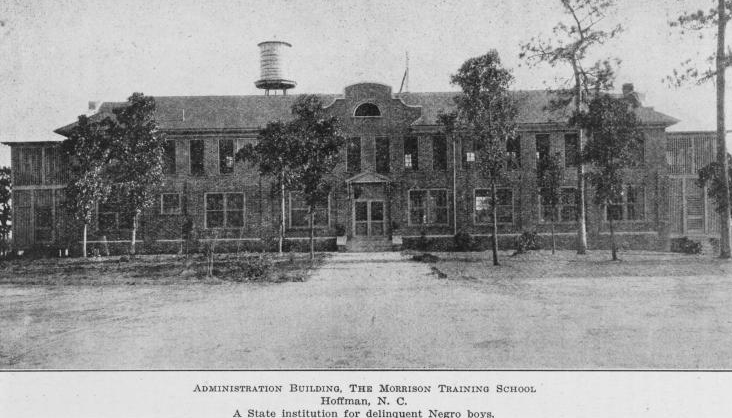 (Source: http://digitalgallery.nypl.org/nypldigital/dgkeysearchdetail.cfm?trg=1&strucID=607397&imageID=1253742&total=17&num=0&word=21273&s=1¬word=&d=&c=&f=13&k=0&lWord=&lField=&sScope=Name&sLevel=&sLabel=North%20Carolina%20State%20Board%20of%20Charities%20and%20Public%20Welfare&imgs=20&pos=14&e=w)
(Source: http://digitalgallery.nypl.org/nypldigital/dgkeysearchdetail.cfm?trg=1&strucID=607397&imageID=1253742&total=17&num=0&word=21273&s=1¬word=&d=&c=&f=13&k=0&lWord=&lField=&sScope=Name&sLevel=&sLabel=North%20Carolina%20State%20Board%20of%20Charities%20and%20Public%20Welfare&imgs=20&pos=14&e=w)
The Morrison Training School was established in 1923, according to the North Carolina Department of Corrections website. Morrison Training School was originally a boys’ training school for Blacks. The facility opened in 1924, in 1925 housing eight youth. In 1939, its name was changed to Morrison Training School for Governor Cameron Morrison. The name was changed again in 1969 to Cameron Morrison School (Huggins, p.1). The facility closed and then reopened as a prison in 1977. Morrison and Sandhills Youth Center were organized as the Sandhills Youth Complex (Huggins, p.1). In 1978, three of Morrison’s dormitories were converted to house 100 women inmates. In 1988, Cameron Morrison Youth Center’s name was changed to Morrison Youth Institution (Huggins, p.1). From 1988 to 2002, Morrison Youth Institution served as a medium security prison for young male felons, 18 to 21 years of age. In January 2002, Morrison was converted to a medium security for adult males, and renamed Morrison Correctional Institution, to help meet the state’s growing need for adult male prison bed space. The youth inmates transferred to other youth prison facilities. In July 2002, Impact East was closed and was reopened in June 2003 to house minimum security youthful offenders.
The North Carolina Farm Colony (State Industrial Farm Colony for Women), as analyzed by Cahn (2007, pp. 168-72), was also "feeder institution" that held deviant female teenagers and others before having them transferred to an institution for the "feebleminded" and sterilized.
Opposition
Blacks were opposed to
sterilizations one two levels: those who knew about its racial bias and those
who didn’t. The sterilization program was only whispered about in the
black communities, and any evidence that race played a part in those who were
sterilized wasn’t made public or scrutinized. Therefore, the eugenics
board was allowed to proceed with few hurdles (Winston-Salem). Those
blacks knew about the racial bias involved with sterilization tried to push for
their rights. In 1959, State Senator Jolly introduced a bill that would
authorize the sterilization of an unmarried woman who gave birth for the third
time. This bill was contested by group of blacks. However, the
senator's response was "You should be concerned about this bill. One
out of four of your race is illegitimate." Blacks that demanded to
be heard were ruled out of order by the white-controlled legislature
(Winston-Salem, "Wicked Silence").
Some college students
were in opposition to the sterilizations. In 1960, students
from North Carolina A&T State University began sit-in
movement against states progressive attitude or race relations. However,
this gained little speed or recognition by the state to make any changes.
Also, at Shaw University in Raleigh from 1968 to 1972, student activists tried
to educate blacks about the issues and threats of sterilization. However,
they lacked detailed information, and therefore this gained little momentum as
well (Winston-Salem, “Wicked Silence”).
Today, North Carolina is trying to amend for its past, making it one of the only states to do so thus far. In April 2003, the sterilization law was unanimously voted to be overturned by the North Carolina Senate. A few weeks later, a law was then signed by Governor Easley to officially put an end to forced sterilizations in North Carolina. Soon after, on April 17, 2003, Easley issued a public apology, stating, “To the victims and families of this regrettable episode in North Carolina's past, I extend my sincere apologies and want to assure them that we will not forget what they have endured" ("Easley Signs Law Ending State’s Eugenics Era," p. 1). Then, in December 2005, the National Black Caucus of State Legislators passed resolution calling for federal and state programs to identify victims nationwide and get them health care and counseling (Sinderbrand, p. 1). However, these current efforts to find sterilized victims are difficult due to budget constraints and high costs of a publicity campaign. Therefore, efforts to find victims through "free media" were employed, such as posting info on bulletins, offices, health departments, libraries, schools, billboards, and city buses etc. (Sinderbrand, p. 1).
A task force created by the governor has considered providing compensation for victims (NC Justice for Victims Foundation). (http://www.sterilizationvictims.nc.gov/). A recent NY Times report described developments up to Dec. 2011.
Bibliography
Ariyo,
Oluwunmi. 2006. “Making the ‘Unfit’ Individual: Analysis of the
Rhetoric of the Eugenics Board of North Carolina.” Master’s Thesis,
Department of Communication, Wake Forest University.
Cahn, Susan. 2007. Sexual Reckonings. Cambridge, Massachusetts: Harvard University Press.
Castles, Katherine. 2002. “Quiet Eugenics: Sterilization in North Carolina's Institutions for the Mentally Retarded, 1945-1965.” Journal of Southern History 68: 849-78.
Caswell Developmental Center. Available at <http://www.caswellcenter.org/History/history.html>
Gardella, John E. 1995. “Eugenic Sterilization in America and North Carolina.” North Carolina Medical Journal; 56 (2): 106-10.
Huggins, J C. 1995-2011. North Carolina Department of Correction. Available at <http://www.doc.state.nc.us/dop/prisons/morrison.htm>
Krome-Lukens, Anna L. 2009. “A Great Blessing to Defective Humanity: Women and the Eugenics Movement in North Carolina.” Master’s thesis, Dept. of History, University of North Carolina at Chapel Hill.
Larson, Edward J. 1995. Sex, Race, And Science: Eugenics In The Deep South Baltimore. Baltimore: Johns Hopkins University Press.
Noll, Steven. 2005. “The Public Face of Southern Institutions for the ‘Feeble-Minded.’” The Public Historian 27, 2: 25-42.
------. 1995. Feeble-Minded in Our Midst: Institutions for the Mentally Retarded in the South, 1900-1940. Chapel Hill: University of North Carolina Press.
North Carolina Department of Administration. “North Carolina Justice for Sterilization Victims Foundations.” Available at http://www.sterilizationvictims.nc.gov/
Paul, Julius. 1965. “Three Generations of Imbeciles are Enough: State Eugenic Sterilization Laws in American Thought and Practice.” Unpublished ms. Washington, D.C.: Walter Reed Army Institute of Research.
Reynolds, Dave. 2003a. "Bill To Overturn Eugenics Law Passes State Senate." Inclusion Daily Express: International Disability Rights News Services (April 4).
------. 2003b. "Easley Signs Law Ending State’s Eugenics Era." Inclusion Daily Express: International Disability Rights News Services (April 17).
Schoen, Johanna. 2011. “Reassessing Eugenic Sterilization: The Case of North Carolina.” Pp. 141-60 in A Century of Eugenics in America: From the Indiana Experiment to the Human Genome Era, ed. Paul Lombardo. Bloomington: Indiana University Press.
------. 2005. Choice and Coercion: Birth Control, Sterilization, and Abortion in Public Health and Welfare. Chapel Hill: University of North Carolina Press.
Severson, Kim. "Thousands Sterilized, a State Weighs Restitution." NYTimes.com Dec. 9, 2011. Available at <http://www.nytimes.com/2011/12/10/us/redress-weighed-for-forced-sterilizations-in-north-carolina.html>.
Sinderbrand, Rebecca. 2005. "A Shameful Little Secret." Newsweek 33 (March 28).
State Library of North Carolina. "Eugenics in North Carolina." Available at < http://statelibrary.dcr.state.nc.us/dimp/digital/eugenics/index.html. >
Wiggins, Lori. 2005. “North Carolina Regrets Sterilization Program.” Crisis 112, 3: 10.
Winston-Salem Journal. Against Their Will. Available at <http://againsttheirwill.journalnow.com/>.